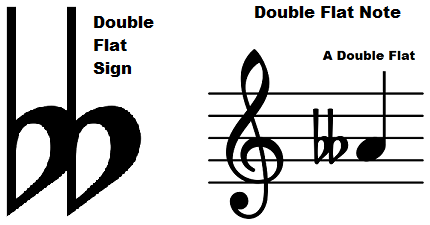Let’s now take a look at the double flat sign. We have already talked about the other accidental signs, namely, the sharp sign,flat sign and double sharp sign. The double-flat is the opposite of the double sharp. It is the equivalent of two flats, and lowers a note’s pitch by two half steps or semitones. This is equal to one whole step or tone.
Highly Recommended: Click here for one of the BEST piano/keyboard courses I’ve seen online.
It is represented by this symbol: ![]() . In type it is written like this: bb, for example Dbb. In music notation, this symbol is placed before a note, like other accidentals.
. In type it is written like this: bb, for example Dbb. In music notation, this symbol is placed before a note, like other accidentals.
Let’s say you come across a D note in a piece of music but there is a double flat symbol before it. This simply means that you are to play the key which is two semitones lower. In this example, you are to play C. So Dbb is the equivalent of C on your piano. Ebb is the enharmonic equivalent of D. Gbb is the enharmonic equivalent of F, and so on. Each time, we go two half steps lower. Enharmonic notes are notes with different names but played with the same key.
In most instances, when you come across a double flat sign, you are to play a white key. But this is not always the case. Cbb is a black key on your piano. It’s Bb. The other exception is Fbb which corresponds to Eb, a black key on your piano. This is because Cb points to the natural key B, and Fb points to the natural key, E. Go down by one more semitone and you end up on a black key. 
What’s the point of a double-flat sign? Why not just write C? Why write Dbb. Why not F instead of Gbb? This is a question often asked by beginners. Here’s a scenario which would require the use of a double flat. Let’s say you’re composing in the key of Cb major which has seven flats, Cb-Db-Eb-Fb-Gb-Ab-Bb. What would you do if you wanted to write a G natural in a measure where there are lots of Gb’s? Instead of alternating between writing G natural and G flat, you could simply write an A double-flat, and indicate that one should play G. As a result, less accidentals are used. This makes it simpler and less confusing.
In a musical piece, a double flat symbol alters the pitch of the note to which it is attached, as well as any subsequent occurrence of the same note in the same measure. These notes have to be on an identical line or space. If they are in a higher or lower octave, they are not affected. When the measure ends, the double flat no longer has an effect on notes, except if there’s a tie across a barline that carries a double-flatted note to the other side of the barline. Any notes in the new measure that are not tied, go back to their original pitch, as indicated by the key signature.
A double-flat is always indicated by two flat signs, regardless of the key signature. Let’s say you are in the key of F, adding a flat sign to the note, Bb on the third line won’t make it a B double-flat. To indicate a Bbb you must add the second flat.
How do you cancel a double flat? You simply use a single flat symbol. This would indicate that the pitch in that measure should only be lowered by a half step. In rare situations, a natural symbol and flat symbol are combined. The natural symbol would in effect raise the pitch by a semitone, while the flat symbol would lower it by a semitone. This can confuse the player so it’s better to simply use a single flat symbol.
I highly recommend Piano For All to piano students. Click here to learn all about the Piano For All piano lessons.